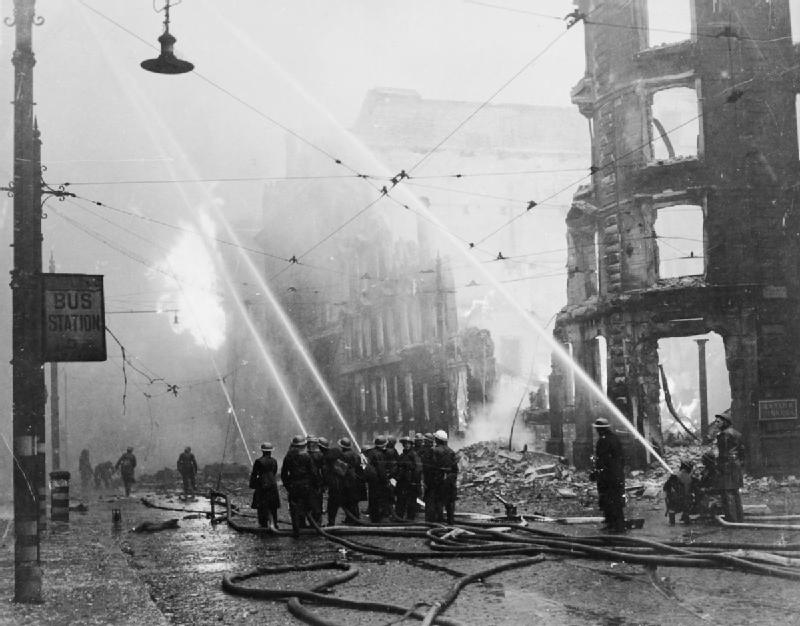The Manchester Blitz (also known as the Christmas Blitz) was the heavy bombing of the city of Manchester and its surrounding areas in North West England during the Second World War by the Nazi German Luftwaffe. It was one of three major raids[a]A major raid is one in which 100 or more tons of high explosive are dropped.[1] on Manchester, an important inland port and industrial city; Trafford ParkFirst planned industrial estate in the world, and still the largest in Europe. in neighbouring StretfordOne of the four major urban areas in the Metropolitan Borough of Trafford, Greater Manchester. was a major centre of war production.
Raids on Manchester
Air raids began in August 1940, and in September 1940 the Palace Theatre on Oxford Street was bombed. The heaviest raids occurred on the nights of 22/23 and 23/24 December 1940, killing an estimated 684 people and injuring more than 2000. Manchester Cathedral, the Royal ExchangeFormer cotton exchange damaged by two bombs, now comprising a theatre and shopping centre. and the Free Trade HallPublic hall constructed in 1853–1856 on St Peter's Fields, the site of the Peterloo Massacre, now a Radisson hotel. were among the large buildings damaged. On the night of 22/23 December, 272 tons of high explosive were dropped, and another 195 tons the following night. Almost 2000 incendiaries were also dropped on the city over the two nights.[1] The aircraft spread fanwise and adopted the by then familiar tactic of dropping flares followed by incendaries and high explosives with later waves targeting the fires caused by the earlier attacks. There were other less intensive bombing raids across Britain,[2] and two German aircraft were reported to have been lost over the British Isles on 24 December; one crashed in the sea near Blackpool and the other, loaded with incendaries and flares, crashed in flames near Etchingham, Sussex with no survivors.[3]
Stretford and Salford
Neighbouring Salford, StretfordOne of the four major urban areas in the Metropolitan Borough of Trafford, Greater Manchester. and other districts were also badly damaged by the bombing. It is estimated that more than 215 people were killed and 910 injured in Salford, and more than 8000 homes were damaged or destroyed.[1] Seventy-three were killed in Stretford, and many more were injured.[4] The following month Old Trafford was hit during an air raid that lasted for three hours. In June 1941 German bombs damaged the original Salford Royal Hospital on Chapel Street at the junction with Adelphi Street, killing 14 nurses.[5]
Further raids
On 11 March 1941 Old Trafford football stadium, the home of Manchester United F.C., was hit by a bomb that completely destroyed the main stand and badly damaged the pitch and parts of the terracing.[6] The stadium was rebuilt after the war and reopened in 1949, until which time United played at Manchester City’s Maine Road stadium.[7]
In June 1941 German bombs damaged the police headquarters. Manchester continued to be bombed by the Luftwaffe throughout the war, and was in some danger of being hit by V-1 flying bombs. On Christmas Eve 1944, Heinkel He111 bombers flying over the Yorkshire coast launched 45 flying bombs at Manchester. No V-1s landed in Manchester itself, but 27 people in neighbouring Oldham were killed by a stray bomb. Another 17 were killed elsewhere and 109 wounded. RAF De Havilland Mosquitos shot down one German bomber over the North Sea and severely damaged another, causing it to crash land in Germany.[8]

